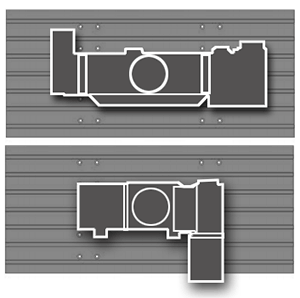310 mm (12.2″) Servo Rotary Table. Requires Haas mill with 4th-axis drive for full 4th-axis operation, or a rotary control box for stand-alone operation. Requires a Haas mill with software version 18.00 or later.
HRT310
1
SPINDLES
310 mm
COLLET SIZE
300 ft-lb
MAX TORQUE
75 °/sec
MAX SPEED

Overview
Specs
Video
Resources
HRT310 - Compare to


| HRT310 | ||
|---|---|---|
| Platter | S.A.E. | METRIC |
| Diameter | 12.2 " | 310 mm |
| Number of Std T-Slots | 6@ 60° | 6@ 60° |
| Spindle | S.A.E. | METRIC |
| Max Speed | 0.001 to 75 °/sec | 0.001 to 75 °/sec |
| Max Torque | 300 ft-lb | 407 Nm |
| Runout Max | 0.0010 " | 0.025 mm |
| Backlash | 30 arc-sec | 30 arc-sec |
| Center Height | 9.000 ± 0.001 " | 228.60 ± 0.03 mm |
| Gear Ratio | 72:1 | 72:1 |
| Timing | 2:1 | 02:01:00 |
| Spindle Bore ø | 3.250 x 9.875 " | 82.55 x 250.83 mm |
| Brake Torque @ 100 psi/6.9 bar | 500 ft-lb | 678 Nm |
| Indexing | S.A.E. | METRIC |
| Max Rotation/Step | 999.999 ° | 999.999 ° |
| Resolution | 0.001 ° | 0.001 ° |
| Accuracy (±) | 15 arc-sec | 15 arc-sec |
| Repeatability | 10 arc-sec | 10 arc-sec |
| Worm Gear Dia | 9.4 " | 235 mm |
| GENERALS | S.A.E. | METRIC |
| Power Requirement | 115 ± 10% VAC @ 15 A | 115 ± 10% VAC @ 15 A |
| Air Pressure Max | 150 psi | 10.3 bar |
| Operating Temp (max ambient) | 100 °F | 38 °C |
| Duty Cycle full/low speed | 50/100 % | 50/100 % |
| Weight | S.A.E. | METRIC |
| Brushless Control | 14.2 lb | 6.4 kg |
| Table | 435 lb | 197.3 kg |
N/A
Manual
SEE OUR ROTARIES IN ACTION
Haas VMCs and Rotary Tables - A Perfect Combination
Take a quick look at just a few examples of how our machine and rotary combinations can help you get your difficult multi-sided parts done better.
Don’t Fear 5-Axis - Parts 1, 2 and 3
Senior applications engineer John Nelson explains why 5-axis machining is much simpler than it has ever been before, and why any shop can be a 3+2 or 5-axis shop.
Learn how the Haas software feature DWO and TCPC (Dynamic Work Offsets and Tool Centre Point Control) makes 4th and 5th-axis work simpler than ever.
Haas VF-2SS & HRC210 Demo
This demo was designed to show off the higher spindle speed and rapids of the VF-2SS and the quickness of the HRC210.
You can also see in-process probing for part location and feature inspection using the Haas WIPS system.
Haas Rotary QuickChange System and Block Fixtures
We’ve touched on the QuickChange and Block accessories available for Haas rotary tables in several of our other videos. This video focuses specifically on those accessories. So if you’re looking to get more productive with your rotary part fixturing, be sure to watch this!




